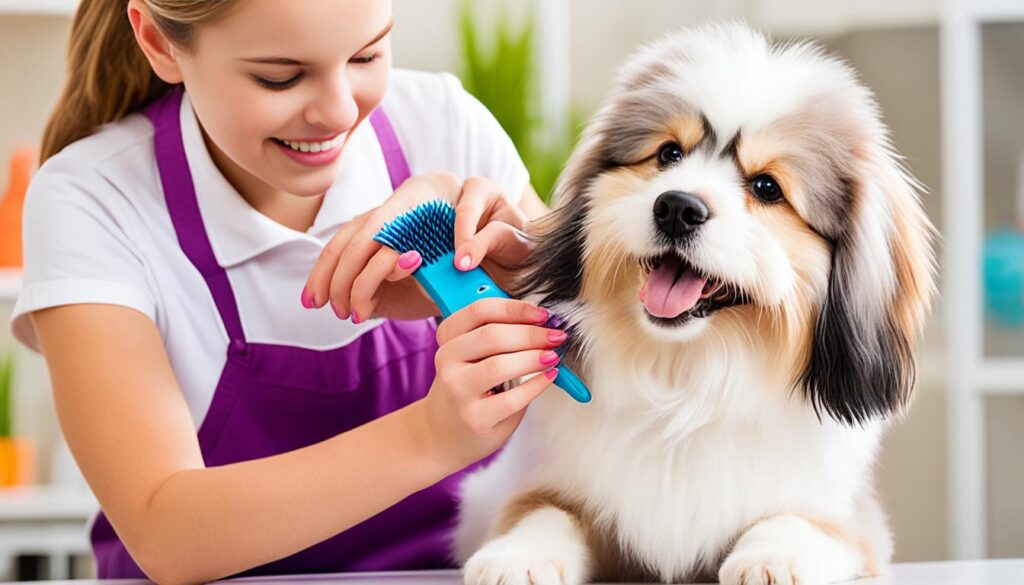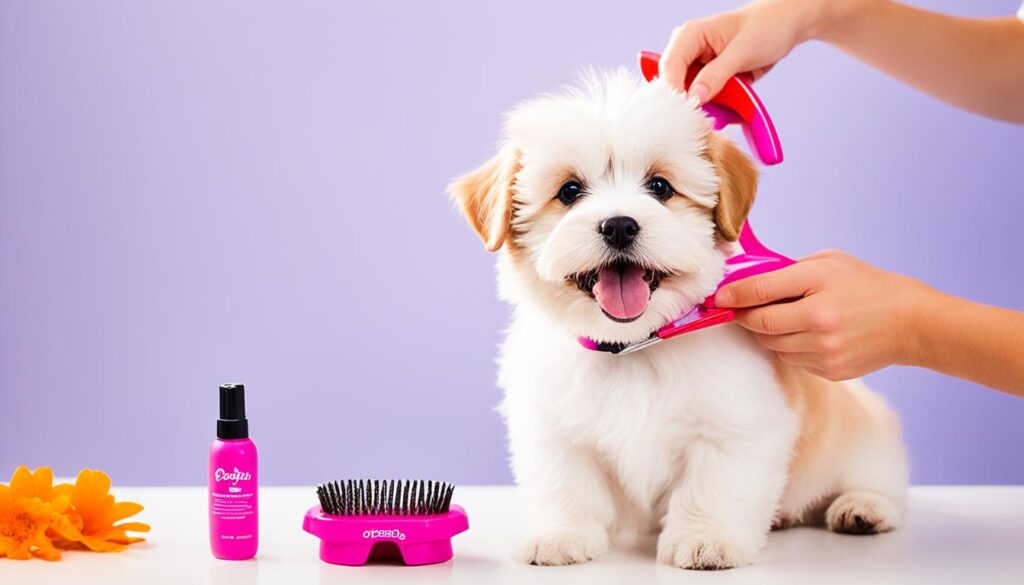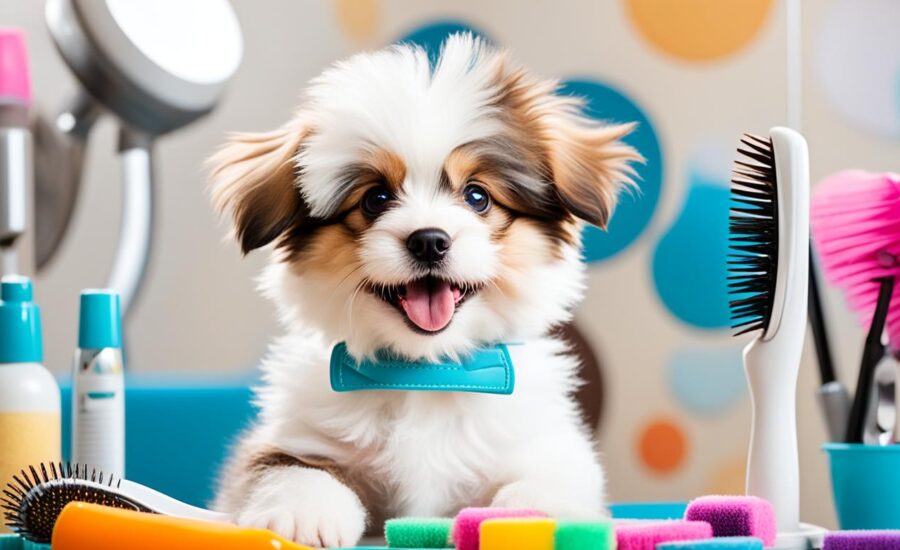It’s not just people who enjoy being clean and good-looking—our pets need care and love too. Getting your pet used to grooming is more than just making them look nice. Introducing pets to grooming helps them feel comfortable with a routine that keeps them healthy and happy. It’s smart to start this early. But you might wonder, how early is okay? And why does it even matter? If you’re thinking about teaching pets grooming basics or creating a grooming routine for pets, starting soon is key. Experts in many places say teaching pet grooming tips early helps pets not stress over staying clean. Let’s delve into why starting young with grooming is good and how to do it properly.
Key Takeaways
- Starting a grooming routine at a young age can greatly benefit your pet’s lifelong comfort and health.
- Early grooming teaches pets to accept various procedures like brushing, bathing, and nail trimming calmly.
- Professional groomers recommend that puppies begin grooming sessions as early as 12 weeks old.
- Grooming should be a stress-free, bonding experience that fosters a pet’s positive outlook toward hygiene practices.
- Identifying tailored grooming routines for pets can prevent common health concerns and ensure peaceful grooming encounters.
- It’s crucial to use the right grooming tools and techniques to acquaint young pets with the grooming process.
Understanding the Importance of Early Grooming
Getting your pet used to grooming early on is more than just about looks. It’s crucial for their health and happiness. Early grooming teaches puppies not to fear the process but to see it as a normal part of life.
The Benefits of Starting Young
Introducing a puppy grooming guide from the start helps with cleanliness and getting along well during grooming. Puppies are curious and flexible in their early months, making it ideal to start grooming lessons. Regular grooming early on eases future grooming and vet visits anxiety.
Creating Positive Associations With Grooming
Turning grooming into a bonding experience helps by linking it with love and rewards. This approach makes future grooming easy and fun. It builds trust, making every grooming session a positive event.
Long-term Health Implications for Your Pet
Starting grooming habits early benefits your pet throughout their life. Here’s how early grooming routines support their long-term health:
| Aspect | Benefits of Early Grooming |
|---|---|
| Coat Health | Prevents matting, reduces shedding, and identifies skin issues early. |
| Dental Care | Good oral hygiene can prevent periodontal diseases and protect against heart and kidney issues. |
| Nail Clipping | Regularly trimmed nails keep paws healthy and prevent painful nail problems. |
| Ear Cleaning | Early cleaning avoids wax buildup that can lead to infections. |
A smooth intro to grooming avoids your pet’s discomfort and gets them used to being handled. Starting young reduces stress-related problems and boosts their trust in people. It paves the way for a happy, healthy future.
How to Introduce Your Pet to Grooming at a Young Age
Bringing a new pet home means more than just fun and games. You must teach them how to be groomed early on. This keeps them healthy and happy. We’ll share tips on making grooming enjoyable for you and your pet.
Step-by-Step Guide for Initial Grooming Sessions
Start in a calm place to keep your pet comfy. Keep grooming sessions short and happy at the start. Slowly, you can groom them for longer periods. The key is being patient and consistent with your pet.
- Start with brief touching sessions, gently handling paws, ears, and tail.
- Introduce a soft brush, letting them sniff and explore it before gently running it through their fur.
- For nail trimming, begin by pressing their paws to extend the nails, rewarding them with treats to build positive associations.
- Move onto simulated grooming sounds, like buzzing from clippers or the snapping of scissors, to acclimate them to the noises they’ll encounter during a grooming session.
Introducing Grooming Tools and Products
Show each grooming tool and product to your pet one by one. Let them check out each item. This helps them get used to the new sensations.
Treats and praise are invaluable for reinforcing calm behavior around grooming tools and products.
- Let your pet investigate the brush or comb by placing it near their bedding or playing area.
- Show them the shampoo during bath time, associating it with gentle massages and warm water.
- Familiarize your pet with a nail clipper or grinder by associating it with positive experiences and treats before actual use.
Handling and Conditioning Techniques for Puppies
Puppies may learn to enjoy grooming if you handle them gently. Practice makes perfect and builds trust.
Always be gentle when practicing handling techniques, ensuring that your pet’s first experiences are stress-free and soothing.
- Touch and hold paws during playtime, incrementally increasing pressure to mimic nail trimming.
- Gently lift and part their fur, simulating the motions of a grooming session.
- Implement a restful massage after play to relax them and create a positive end to grooming practices.
Teach grooming early to make it a happy habit for life. With kindness and patience, grooming becomes just another part of their day. And yes, treats help a lot!
Setting Up a Grooming Routine for Ultimate Comfort
The key to grooming your pet well is having a regular grooming routine for pets. This plan should include daily care and regular check-ups. It’s important for your pet’s health and happiness.
Here’s a simple guide for pet owners to create a good grooming schedule:
- Daily Coat Brushing – To prevent matting and to distribute natural oils throughout the coat.
- Weekly Ear Checks – To monitor and clean, minimizing the risk of ear infections.
- Monthly Nail Trims – To maintain proper foot health and posture.
- Regular Baths – According to the pet’s individual needs to ensure a clean, healthy coat.
- Bi-Annual Dental Cleaning – To keep oral hygiene in check and prevent gum disease.
Adding these pet grooming tips into your routine does more than keep them clean. It lets you check your pet for any health changes. Knowing how to keep up with these tasks brings comfort to your pet.
| Grooming Activity | Frequency | Benefits |
|---|---|---|
| Coat Brushing | Daily | Eliminates tangles, keeps fur smooth, and reduces shedding. |
| Ear Cleaning | Weekly | Prevents infections, removes buildup, and checks for parasites. |
| Nail Clipping | Monthly | Safeguards against joint pain, improves mobility and prevents ingrown nails. |
| Bathing | As needed | Cleanses skin, refreshes coat, and can offer flea treatment. |
| Dental Care | Bi-Annually | Removes plaque, prevents tooth decay, and freshens breath. |
Remember, being patient and encouraging is key when starting a grooming routine. Over time, grooming can be fun for your pet. It makes your bond stronger and keeps them healthy and happy.

Finding the Right Groomer for Your Young Pet
Starting the journey of grooming your pet can seem tough but it’s important. When looking for the right groomer for your young pet, it’s crucial to choose carefully. A good groomer can change your pet’s grooming routine for the better. This guide will help you find the best grooming services for your pet.

Researching and Selecting a Skilled Professional
Look into groomers before making a choice. Check their certifications, read reviews, and get tips from pet owners. A great groomer does more than make your pet look good; they understand your pet’s specific grooming needs too.
Preparing for the First Grooming Appointment
Before the first visit, make sure your pet knows basic commands and how to behave on a leash. It helps if they’re also used to car rides. Visiting the salon first can help ease any worries by showing how pets are treated there.
Questions to Ask Your Prospective Groomer
When talking to a groomer, ask about their experience and the products they use. Find out how they handle pets that are scared or nervous. Make sure they’re strict about requiring vaccinations too.
| Grooming Service | What to Expect | Questions to Ask |
|---|---|---|
| Bathing and drying | Thorough cleaning with breed-appropriate products | What types of shampoo and conditioner do you use? |
| Haircuts and styling | Styling that complements your puppy’s breed and lifestyle | How do you keep up with current breed standards? |
| Nail trimming | Safe trimming to a comfortable length | How do you ensure the nails are trimmed to the appropriate length without causing stress? |
| Ear cleaning | Gentle removal of debris and prevention of infections | Can you identify and respond to signs of ear infections? |
With this info, finding the right groomer for your young pet becomes easier. You’ll be well-equipped to make a smart choice, ensuring your pet is happy and looks great.
Conclusion
Starting grooming early for pets is like helping a plant grow. It needs time, effort, and the right methods. You create a good future by making grooming a fun habit early on. This article showed the big benefits of early grooming for young pets. It does more than make them look good—it boosts their health and strengthens your bond.
We start by getting your pet used to being touched. Then, we slowly introduce them to grooming tools. Finally, we choose the best grooming expert for them. This helps your pet feel okay and confident during grooming. It is really important as it leads to a healthy lifestyle and shows how crucial regular care is.
Our main aim is to look after our pets’ inner well-being, not just their looks. Starting a grooming routine early supports their best life. It means a life of comfort, good health, and feeling loved. Let’s use these ideas in our pet care, making our pets both well-groomed and deeply loved.
FAQ
Why is it important to introduce my pet to grooming at a young age?
What are the benefits of starting the grooming routine for pets early?
How can I create a positive association with grooming for my pet?
What are the long-term health implications if my pet is not groomed regularly from a young age?
How do I conduct the initial grooming sessions step-by-step?
How can I introduce my pet to grooming tools and products without causing fear?
What handling and conditioning techniques are effective for grooming training?
What should a grooming routine for my pet include?
How do I find the right groomer for my young pet?
What should I prepare for my pet’s first grooming appointment?
What are some important questions to ask a prospective groomer?
Source Links
- https://alldogsinc.com/dog-safety/at-what-age-should-you-start-grooming-your-dog/
- https://www.petmd.com/dog/general-health/grooming-tips-new-puppy
- https://bentonville.earthwisepet.com/content/other/5-Steps-to-Introduce-Your-Puppy-to-Grooming/

